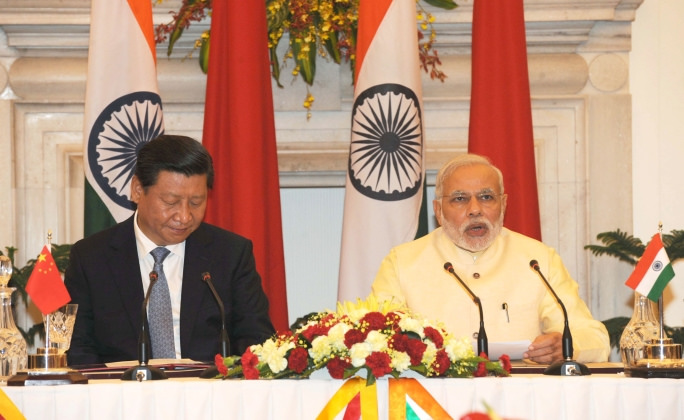Few, if any, geopolitical and economic relationships are more essential to the global community than those of China and India. Everything about the two nations and their connection is big: the size of their populations (first and second in the world, respectively), their gross national incomes (second and tenth, respectively), their historical spheres of influence, and even the gigantic Himalayan boundary that separates them. Each has given birth to great world religions, fearsome and expansive empires, and awe-inspiring populist movements. The last few decades have witnessed massive upheavals in both nations; after the death of Chairman Mao, China gradually opened up to global commerce and liberalized its economy while tightening its one-party state, while India’s skyrocketing workforce and growing middle class contribute to the world’s largest democracy. States with this much impact inevitably face rivals: India has squared off with Pakistan over Kashmir since both gained independence from Great Britain, and China is embroiled in territorial disputes with Japan, Vietnam, Malaysia and others.
Crucially, India and China have also fought one another. Relations between the two new nations began positively enough, with India being among the first to recognize the People’s Republic as the legitimate representative of the Chinese people. The nascent Congress Party government in Delhi led by Jawaharlal Nehru and the Communist regime in Beijing negotiated the Panchsheel Treaty in 1954, which enumerated the “Five Principles of Peaceful Coexistence” that sought to solidify friendly relations between them. This goodwill did not last long, however: Five years later, Chinese-occupied Tibet erupted in violence and the Dalai Lama sought refuge in India. Distrust grew as both nations laid claim to the border region of Aksai Chin, culminating in the 1962 Sino-Indian War, which ended in a tense ceasefire. Conditions on the border have essentially remained unchanged since the war, with China controlling the territory but India claiming it as part of Kashmir.
The present-day relationship is complex. Globalization has made cooperation beneficial, but the two countries have different visions for the continent as they both vie for regional hegemony. Recent events have brought these aspirations to the fore. India’s parliamentary elections in May resulted in the end of Congress Party rule, with the new Bharatiya Janata majority, led by Narendra Modi, intent on pursuing India’s interests and oftentimes employing nationalist rhetoric to frame its goals. Elected primarily on economic platform, it would seem the BJP would have an interest in ties with China; however, it took issue with Congress Party policy towards China repeatedly, citing what it saw as weak and defensive postures with regards to disputed demarcation lines and China’s close ties with Pakistan. Furthermore, a deep mistrust of China by Indians still lingers from the war.
In this context, two weeks ago President Xi Jinping made the first official visit to India by a Chinese head of state in eight years, and only the third since the war. With the BJP’s economic objectives in mind, the invitation of Xi is promising, since trade is a surefire way of ensuring the Asian giants stay on good terms. However, Modi’s invitation to Xi seems to be a power play. A summit on Indian soil signals India’s new, realist approach to international politics, and a warning to China that India will now conduct its foreign relations on its own terms. “[Modi’s] message is that it’s all very nice to talk about business,” said K. Shankar Bajpai, former Indian ambassador to China, “but this territorial stuff is not an area where you can play ducks and drakes with us as you have in the past.”
What does this shifting dynamic mean for the region and the world? Certainly, an India-China detente is desirable. Chinese investment in India’s infrastructure would be a boon for India’s economic prospects, and would very likely deliver a high return for China. A security partnership and agreement on an official border would provide India greatly needed assistance in its counterterrorism operations and would defuse the tense situation in Aksai Chin, benefitting not only both countries but also the region as a whole. These advantages in and of themselves, however, are not guarantors that the states will put aside their issues. China’s relationship with Japan, particularly over the last few years, reflects a similar set of issues. Japanese Prime Minister Shinzo Abe, similarly to Modi, utilizes aggressive rhetoric and appeals to nationalistic sentiments to legitimize his goals. While Japan is a huge trading partner of China and the two nations share historical linkages, the explosive nature of their recent interactions reveals no initiative on either side to cooperate. Opinions of the opposite party are shockingly bad, with 90 percent of Chinese citizens viewing Japan in an unfavorable light.
Thankfully, China and India do not possess the same animosity towards one another that China and Japan do; nevertheless, Modi’s right-wing leadership threatens to break down this consequential partnership. The recent summit ended without much in the way of concrete success, and the border dispute remained contentious. At the very least, however, leaders from the two nations established a precedent for productive interaction going forward. Regardless of whether Modi aims to increase trade or assert India’s role as a regional presence, continued conversation among these leaders will be essential for a stable and prosperous Asia for years to come.
